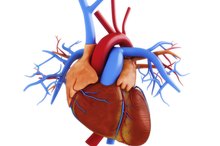Elevated Liver Enzymes and the Gallbladder
The liver is one of the main organs of digestion. In addition to its role in hormone production and protein synthesis, it manufactures bile, which is essential to the digestion of dietary fats. **Bile is stored in the gallbladder, a tiny organ located behind the liver 3. Because of their intimate association, gallbladder dysfunction can adversely affect the liver, manifesting as an elevation in certain key enzymes, namely the transaminases ALT and AST.
If you are experiencing serious medical symptoms, seek emergency treatment immediately.
Liver Enzymes
The liver produces several enzymes involved in metabolism. Among them, the aminotransferases, also called the transaminases, ALT and AST, which function in protein metabolism, have particular diagnostic value, as they become elevated in several diseases, including those of the liver and gallbladder in addition to disorders of other tissues, including the heart and muscle. Because of this generalization to a variety of organs, clinicians often use findings on physical exam and other clinical signs to guide diagnosis.
Elevated Levels
Birth Control Pills & Elevated Liver Enzymes
Learn More
Aminotransferases are normally present inside the cell, with low levels found in the blood. The presence of elevated blood levels of aminotransferases indicates damage to cells rich in these enzymes, especially to the cells of the above-named organs. The damage may be due to a chronic disease, such as cancer, or a sudden insult as occurs in a heart attack, or when a gallstone lodges in the bile duct and causes bile congestion.
Gallbladder Disease
Gallstones, also known as cholelithiasis, are the most common type of gallbladder disease, affecting 10 percent of the population. The risk of gallstones increases with age and is more common in women. Other factors that predispose include obesity, pregnancy and rapid weight loss. Sometimes a stone may become lodged in the duct and lead to inflammation of the gallbladder, called cholecystitis, and of the liver, with an associated elevation of liver enzymes.
- Gallstones, also known as cholelithiasis, are the most common type of gallbladder disease, affecting 10 percent of the population.
Liver Enzymes and the Gallbladder
What Does a High SGOT in a Liver Function Test Mean?
Learn More
An elevated alkaline phosphatase is possibly the most sensitive and specific indicator of gallbladder disease. However, this enzyme is not a liver enzyme, per se. Rather, it is a digestive enzyme on the surface of the small intestine. However, the transaminases, ALT and AST, may become elevated before the alkaline phosphatase. Their elevation tends to be less marked than what is seen in liver diseases like hepatitis, which helps to distinguish gallbladder disease from liver dysfunction. Normal levels of these enzymes are 0 to 40 IU/L 13.
- An elevated alkaline phosphatase is possibly the most sensitive and specific indicator of gallbladder disease.
- Rather, it is a digestive enzyme on the surface of the small intestine.
Other Gallbladder Diseases
There are other less common diseases of the gallbladder. Primary sclerosing cholangitis is characterized by inflammation of bile ducts and is often seen in association with inflammatory bowel disease, for example Crohn’s disease. Though this disease is not associated with elevations of transaminases, it can lead to cancer of the bile ducts, which can induce elevations in AST and ALT, in addition to jaundice and liver enlargement, and the symptoms of vomiting and weight loss.
Related Articles
References
- "Pathologic Basis of Disease"; Kumar et al.; 2005
- "Biochemistry"; Champe et al.; 2005
- "The Family Medicine Handbook"; Graber et al.; 2006
- American Cancer Society. Signs and Symptoms of Gallbladder Cancer. Updated July 12, 2018.
- Costi R, Gnocchi A, Di mario F, Sarli L. Diagnosis and management of choledocholithiasis in the golden age of imaging, endoscopy and laparoscopy. World J Gastroenterol. 2014;20(37):13382-401. doi:10.3748/wjg.v20.i37.13382
- Jones MW, Genova R, O'Rourke MC. Acute Cholecystitis. In: StatPearls [Internet]. Treasure Island (FL): StatPearls Publishing; 2019 Jan-. Updated August 10, 2019.
- American Cancer Society. Tests for Gallbladder Cancer. Updated July 12, 2018.
- Abraham S, Rivero HG, Erlikh IV, Griffith LF, Kondamudi VK. Surgical and nonsurgical management of gallstones.Am Fam Physician. 2014 May 15;89(10):795-802.
- Zakko SF, Afdhal NH. (2016). Acute cholecystitis: Pathogenesis, clinical features, and diagnosis. Chopra S, (ed). UptoDate, Waltham, MA: UpToDate Inc.
- Bittencourt PL, Couto CA, Ribeiro DD. Portal vein thrombosis and budd-Chiari syndrome. Clin Liver Dis. 2009;13(1):127-144. doi:10.1016/j.cld.2008.10.002
- Sanders G, Kingsnorth AN. Clinical Review: Gallstones. BMJ. 2007 Aug 11;335(7614):295-99. doi:10.1136/bmj.39267.452257.AD
Writer Bio
Adam Dave, M.D., has written both fiction and nonfiction since 1997. His most recent work, "The Paradigm Diet," a short course on applied nutrition, is available on Amazon. He holds a medical degree from Medical University of the Americas and trained in family medicine at the University of Colorado.









